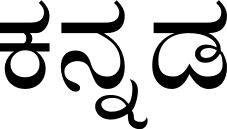Language/Kannada/Grammar/Gender
Hi Kannada learners! 😊
In this lesson, we will talk about gender in Kannada grammar. Gender is an essential part of any language and understanding it is necessary to communicate effectively. Not to mention, it is also interesting to learn about the cultural nuances of gender roles reflected in language. So, let's dive in!
Introduction[edit | edit source]
In Kannada, there are three genders: masculine, feminine, and neuter. Unlike in some other languages, gender is not determined by the biological gender of the person or object being referred to. Instead, it is mostly determined by the nature of the object or the word itself.
Finish this lesson and explore these related pages: Future Tense & Consonants.
Masculine Gender[edit | edit source]
Nouns that refer to masculine objects are classified as masculine gender. Let's look at a few examples:
| Kannada | Pronunciation | English |
|---|---|---|
| ಅಣ್ಣ | ən̪ɳə | Elder Brother |
| ಹುಡುಗ | hʊd̪ug̊ | Boy |
| ಹುಲಿ | hulɪ | Tiger |
Feminine Gender[edit | edit source]
Nouns that refer to feminine objects are classified as feminine gender. Here are a few examples:
| Kannada | Pronunciation | English |
|---|---|---|
| ಅಕ್ಕ | əkːə | Elder Sister |
| ಹೆಣ್ಣು | heɳɳu | Girl |
| ಹೂ | huː | Flower |
Neuter Gender[edit | edit source]
In Kannada, most inanimate objects are classified as neuter gender. Here are a few examples:
| Kannada | Pronunciation | English |
|---|---|---|
| ಮರ | məra | Tree |
| ಮುಖ | mukʰa | Face |
| ಹಿಮ | hima | Snow |
It is worth noting that not all objects follow this rule of gender classification. Some nouns can have different gender classification based on the different contexts they are used in.
Understanding Gender with Examples[edit | edit source]
Let's take a dialogue between two friends, Shivu and Ravi, as an example to understand gender in sentences.
- Shivu: ನೀನು ಯಾರನ್ನು ನೋಡಿದೆ? (neenu yaarannu noDidde?) (Whom did you see?)
- Ravi: ನಾನು ನನ್ನ ಸ್ನೇಹಿತನನ್ನು ನೋಡಿದೆ. (naanu nanna snehithanannu noDidhe) (I saw my friend.)
In this dialogue, the noun "friend" is referred to as "snehitha" which is a masculine noun. If Ravi wanted to refer to a female friend, the sentence would change to:
- Ravi: ನಾನು ನನ್ನ ಸ್ನೇಹಿನಿಯನ್ನು ನೋಡಿದೆ. (naanu nanna snehininyannu noDidhe) (I saw my female friend.)
In this sentence, "friend" is referred to as "snehinii" which is a feminine noun.
Exceptions to the Rule[edit | edit source]
While the gender of objects in Kannada is usually dependent on its nature, there are a few exceptions. Here are a couple of examples:
1. "ಗಂಡು" (gaMDu) which means "male" is a masculine noun, while "ಹೆಣ್ಣು" (heNNu) which means "female" is a feminine noun. However, the word "ಕುರುಡು" (kurudu) which means "blind" is also masculine, even though it doesn't describe a male object.
2. The word "ತಂದೆ" (tande) which means "father" is classified as a masculine noun, while "ತಾಯಿ" (taayi) which means "mother" is a feminine noun.
Conclusion[edit | edit source]
We hope this lesson helped you understand the concept of gender in Kannada. To improve your Kannada Grammar, you can also use the Polyglot Club website. Find native speakers and ask them any questions! Don't forget to check out the Kannada Grammar section for more lessons. Keep practicing and happy learning! 😊
➡ If you have any questions, please ask them in the comments section below.
➡ Feel free to edit this wiki page if you think it can be improved. 😎
Sources[edit | edit source]
Finished this lesson? Check out these related lessons: 0 to A1 Course & How to Use Be.
Videos[edit | edit source]
Kannada Vyaakarana - Kannada Grammar - ಲಿಂಗ - Gender - YouTube[edit | edit source]
Lingagalu /Genders in Kannada //stree Linga Pullinga/Lingagalu in ...[edit | edit source]
Kannada Grammar - Genders - YouTube[edit | edit source]
Other Lessons[edit | edit source]
- Conditional Mood
- How to Use Be
- Give your Opinion
- Adjectives
- Pronouns
- Future Tense
- Negation
- Nouns
- Questions

